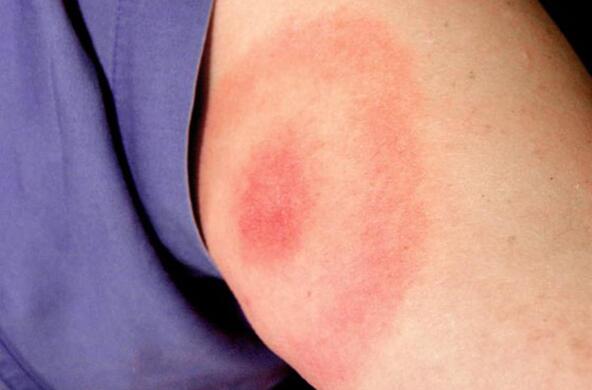Springtime is finally upon us giving everyone a chance to get back outside and enjoy New York’s scenic outdoors. But we’re not alone. Deer ticks are also out hoping to find a free meal from an animal host to feed on. Lyme disease is commonly associated with tick bites but some members of the medical community warn there are several other tick borne illnesses affecting people and if they are not properly treated can lead to long-term chronic illness.
Before heading out onto the mountainous property of the Cary Institute in Dutchess County, I made sure to suit up in white coveralls to help protect myself from deer ticks.
Video report
“This time of year we’ve got adult ticks and then what they like to do is crawl up on vegetation to about thigh height or so and then they will sit there and they’re gonna wait for something warm-blooded to rush by and they’re gonna grab a hold of whatever warm-blooded thing rushes by and that could be you or me or a deer or a raccoon, they’re not gonna be very picky.”
The name of this game is keep the tick on the outside of your clothes, preferably white clothes to stay safe. Or as Dr. Ostfeld puts it, look like a dork.
To find these insects, Dr. Ostfeld drags a white drop cloth along the forest floor, and sure enough, we find two adult females.
“So this is as big as our black legged tick gets, and that is as fast as they can move.”
Adults like this one, are just coming out of suspended animation or tick hibernation and they’re looking to feed on blood for about a week, expanding to the size of a small jellybean.
“Sorry it’s a gross out but its biology.”
What usually puts people in danger is not the adult ticks, it’s the nymph.
“And it is much smaller, it’s about a quarter of the size of those adults. So they’re really hard to feel and really hard to see when they are crawling on you and they are able to take a 3 or 4 day long blood meal from us without us ever knowing.”
It takes 24 to 48 hours for a nymph to transmit a pathogen to its host and that’s where the problems begin.
Dr. Richard Horowitz has been practicing internal medicine in the Hudson Valley for 20 years. In that time the doctor found himself at the forefront of what he describes as a medical epidemic.
“Lyme is a multi-systemic illness. That means that people don’t just come in complaining of a joint pain or fatigue. They usually come in with multiple symptoms.”
He’s had patients who’ve struggled for years with Lyme like symptoms that seem to come and go. Arthritic like joint pain that migrates around the body, nerve pain, stiff neck, headaches, light sensitivity, sound sensitivity, problems with memory and concentration and even insomnia.
“If you have a multi-systemic illness and you’ve been ruled out for other diseases then you need to think about Lyme.”
The problem, Dr. Horowitz says is getting patients properly treated.
He calls Lyme disease “The Great Imitator” as different stands of the disease can easily be easily misdiagnosed as chronic fatigue, meningitis, encephalitis or even bell’s palsy.
To differentiate the infections, Horowitz says he doesn’t send his blood samples to commercial labs looking for one particular strand of Lyme; he uses specialized labs considering the full spectrum of tick borne illnesses, like Babesia whose symptoms mimic malaria.
“A lot of people are confused because they say, chronic lyme disease? The tests are reliable, and it doesn’t persist past 30 days. Well I’m finding that the majority of people who come to see me, they don’t just have lyme they’ve got associated tick borne co-infections.”
So one tick bite can lead too much more than a traditional round of antibiotic treatments can address.
The State Department of Health says while an unprotected person near tick habitats can be exposed to multiple sicknesses, the numbers are still quite low.
“Dealing with tick borne diseases in New York State in many ways you’re dealing with the tick itself. So there’s about 30 different kinds of ticks in New York State and 4 that are of public health importance. The one tick the deer tick carries 4 maybe 5 different pathogens. So when we do prevention messages to the public a lot of that is tick bite prevention, it’s not necessarily tick disease prevention.”
The department of health acknowledges while a single tick bite can lead to multiple infections, it is still quite rare. Which may be why long-term suffers are finding their insurances companies unwilling to foot the bill for multiple tests and medication for care.
That’s where State Senator Terry Gipson steps in with legislation he’s introduced to address that very issue. Gipson was diagnosed with Lyme while on the campaign trail in the summer of 2013 and found himself incapacitated for almost a week. He was traditionally tested and treated early but he says not everyone is that lucky.
“Unfortunately right now, insurance companies are not covering the costs of medications that are associated with long term tick borne illness and that is forcing an awful lot of families throughout the country but especially here in the Hudson Valley to take some pretty drastic measures to deal with those costs. They’re mortgaging their homes, taking on 2 and 3 jobs. And the fact that insurance companies are not covering these costs is really just inexcusable and should not be acceptable.”
As lawmakers and medical professionals try to deal with the diagnosis and treatment of Lyme and other tick borne diseases, back at the Cary Institute biologist Dr. Rick Ostfeld and his research team are working to figure out their origin.
“We know that the mice are by far the most efficient hosts at transmitting these pathogens to ticks, so about 90-percent of the mice in the woods right here are infected with Lyme pathogens. That means that ticks feeding on a mouse have a very, very high probability of infection and becoming dangerous”
He hypothesizes that due to the mouse’s short life span of about 1 or 2 years and their lack of grooming habits, they did not develop a strong immune system so they often carry many infectious diseases.
There is a positive to this tick story.
“We’re in a good place actually. The mouse population crashed last summer and so the larval ticks that were looking for hosts didn’t find as many mice to feed on, so we expect the number of nymphs this summer to be relatively low and the infection rate in those nymphs to be low as well.”
For more information on preventing tick bites visit the state health department website at http://www.health.ny.gov/diseases/communicable/lyme/.








